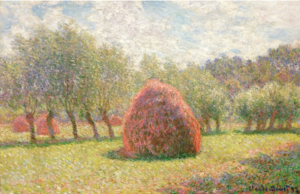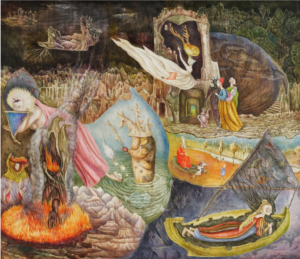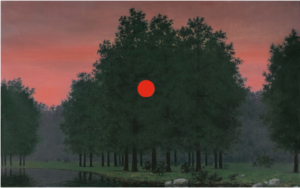
Meules à Giverny by Claude Monet
On Wednesday evening, Sotheby’s New York followed up their string of contemporary sales with something a little older. The Modern Evening sale consisted of fifty lots, mostly by nineteenth- and twentieth-century European and North American masters like Pablo Picasso, Mark Rothko, and Henry Moore. However, for months Sotheby’s advertised the expected star of the sale, one of Claude Monet’s haystack paintings. The original haystacks, or meules, is a series of about twenty-five paintings Monet created in 1890 and 1891. The series’ English translation may be a little misleading since the stacks Monet painted are not hay but are likely wheat or some other kind of grain. He painted these stacks repetitively, each time under different conditions to note changes in weather and light. The meules was the first major painting series Monet did, later moving on to Rouen Cathedral and, most famously, the water lilies in his garden. However, the work offered at Sotheby’s was not part of the artist’s original series. Monet returned to the meules every once in a while, creating the present work in 1893. To the best of our knowledge, it is the last time he ever painted the subject. The consigner acquired the painting in 2001, having last sold at Christie’s in 1983 for just $420K. The bidding started rather high at $26 million, slowing down the closer things got to the $30 million estimate. After over six minutes, a bid of $29.8 million was made. The auctioneer, Sotheby’s Europe chairman Oliver Barker, stayed there for nearly two minutes before the winning $30 million ($34.8 million w/p) bid finally came in; making it the third most valuable of Monet’s meules paintings ever sold at auction.

Les Distractions de Dagobert by Leonora Carrington
Next up was a far more modern work by the British surrealist Leonora Carrington. Les Distractions de Dagobert was created in 1945 when Carrington was experimenting with different materials, which is why Carrington created it with egg tempera paint on a piece of masonite. The painting mainly consists of a pale figure in red robes at the center of the painting, the titular Dagobert, surrounded by his “distractions”, representing the four classical elements of earth, air, fire, and water. It was previously owned by the Pierre Matisse Gallery and was last sold at auction in 1995, selling for $430K hammer. On Wednesday evening, Les Distractions de Dagobert eventually exceeded its $18 million high estimate, with the hammer coming down on $24.5 million (or $28.48 million w/p).
In third place at Sotheby’s was Le Banquet by René Magritte. Magritte created several versions of this particular subject, with the work offered at Sotheby’s omitting the stone wall present in the others. The main motif remains the same, showing a red sunset with the sun disc in front of the trees. In the painting, Magritte presents what Sotheby’s refers to as a “subversion of the fundamental properties of nature”, a theme present in many of his other works, most notably L’Empire des Lumières. Estimated to sell for between $15 million and $20 million, the Magritte sold for $15.5 million (or $18.14 million w/p).

Le Banquet by René Magritte
Overall, the sale was very successful. However, that isn’t terribly surprising since two-thirds of the lots, including the top three, were guaranteed. Throughout the evening, a small handful of surprises crossed the block. Immediately before the Carrington, there was a work by her Spanish contemporary Remedios Varo. Esquiador (Viajero) was estimated to sell for no more than $1.5 million, yet ended up hammering at $3.4 million (or $4.17 million w/p). Then, towards the end of the evening, Pierre Bonnard’s 1925 oil painting Nu s’habillant was meant to sell for no more than $1.2 million. With a provenance that includes Galerie Bernheim-Jeune and Henry Ford II, I guess it’s unsurprising that it achieved slightly more than double its high estimate, going for $2.5 million (or $3.1 million w/p). However, there were one or two slight disappointments along with the surprises. Most notably, a 1941 abstract portrait by Pablo Picasso entitled Femme au chapeau was predicted by Sotheby’s to sell for at least $6 million. The bidding got up to $5.5 million before everything ground to a halt. The painting’s reserve went unmet, and it went unsold.
Despite the Picasso going unsold, Sotheby’s had a rather successful night. Out of fifty lots, twenty-four sold within their estimates, giving Sotheby’s specialists a 48% accuracy rate. Seventeen (34%) sold below estimate, while seven (14%) sold above. Only two lots (4%) went unsold. Against a total presale estimate range of $180.9 million and $250.7 million, Sotheby’s Modern Evening sale achieved $198 million (or $235 million w/p).
Sotheby’s New York Modern Evening Sale
Meules à Giverny by Claude Monet
On Wednesday evening, Sotheby’s New York followed up their string of contemporary sales with something a little older. The Modern Evening sale consisted of fifty lots, mostly by nineteenth- and twentieth-century European and North American masters like Pablo Picasso, Mark Rothko, and Henry Moore. However, for months Sotheby’s advertised the expected star of the sale, one of Claude Monet’s haystack paintings. The original haystacks, or meules, is a series of about twenty-five paintings Monet created in 1890 and 1891. The series’ English translation may be a little misleading since the stacks Monet painted are not hay but are likely wheat or some other kind of grain. He painted these stacks repetitively, each time under different conditions to note changes in weather and light. The meules was the first major painting series Monet did, later moving on to Rouen Cathedral and, most famously, the water lilies in his garden. However, the work offered at Sotheby’s was not part of the artist’s original series. Monet returned to the meules every once in a while, creating the present work in 1893. To the best of our knowledge, it is the last time he ever painted the subject. The consigner acquired the painting in 2001, having last sold at Christie’s in 1983 for just $420K. The bidding started rather high at $26 million, slowing down the closer things got to the $30 million estimate. After over six minutes, a bid of $29.8 million was made. The auctioneer, Sotheby’s Europe chairman Oliver Barker, stayed there for nearly two minutes before the winning $30 million ($34.8 million w/p) bid finally came in; making it the third most valuable of Monet’s meules paintings ever sold at auction.
Les Distractions de Dagobert by Leonora Carrington
Next up was a far more modern work by the British surrealist Leonora Carrington. Les Distractions de Dagobert was created in 1945 when Carrington was experimenting with different materials, which is why Carrington created it with egg tempera paint on a piece of masonite. The painting mainly consists of a pale figure in red robes at the center of the painting, the titular Dagobert, surrounded by his “distractions”, representing the four classical elements of earth, air, fire, and water. It was previously owned by the Pierre Matisse Gallery and was last sold at auction in 1995, selling for $430K hammer. On Wednesday evening, Les Distractions de Dagobert eventually exceeded its $18 million high estimate, with the hammer coming down on $24.5 million (or $28.48 million w/p).
In third place at Sotheby’s was Le Banquet by René Magritte. Magritte created several versions of this particular subject, with the work offered at Sotheby’s omitting the stone wall present in the others. The main motif remains the same, showing a red sunset with the sun disc in front of the trees. In the painting, Magritte presents what Sotheby’s refers to as a “subversion of the fundamental properties of nature”, a theme present in many of his other works, most notably L’Empire des Lumières. Estimated to sell for between $15 million and $20 million, the Magritte sold for $15.5 million (or $18.14 million w/p).
Le Banquet by René Magritte
Overall, the sale was very successful. However, that isn’t terribly surprising since two-thirds of the lots, including the top three, were guaranteed. Throughout the evening, a small handful of surprises crossed the block. Immediately before the Carrington, there was a work by her Spanish contemporary Remedios Varo. Esquiador (Viajero) was estimated to sell for no more than $1.5 million, yet ended up hammering at $3.4 million (or $4.17 million w/p). Then, towards the end of the evening, Pierre Bonnard’s 1925 oil painting Nu s’habillant was meant to sell for no more than $1.2 million. With a provenance that includes Galerie Bernheim-Jeune and Henry Ford II, I guess it’s unsurprising that it achieved slightly more than double its high estimate, going for $2.5 million (or $3.1 million w/p). However, there were one or two slight disappointments along with the surprises. Most notably, a 1941 abstract portrait by Pablo Picasso entitled Femme au chapeau was predicted by Sotheby’s to sell for at least $6 million. The bidding got up to $5.5 million before everything ground to a halt. The painting’s reserve went unmet, and it went unsold.
Despite the Picasso going unsold, Sotheby’s had a rather successful night. Out of fifty lots, twenty-four sold within their estimates, giving Sotheby’s specialists a 48% accuracy rate. Seventeen (34%) sold below estimate, while seven (14%) sold above. Only two lots (4%) went unsold. Against a total presale estimate range of $180.9 million and $250.7 million, Sotheby’s Modern Evening sale achieved $198 million (or $235 million w/p).